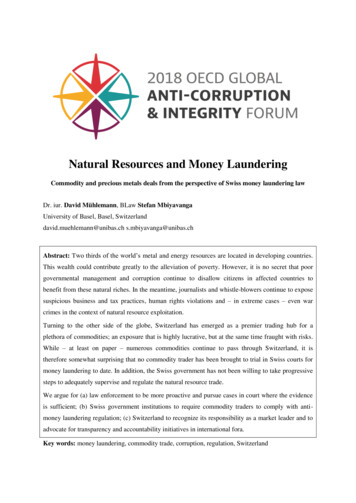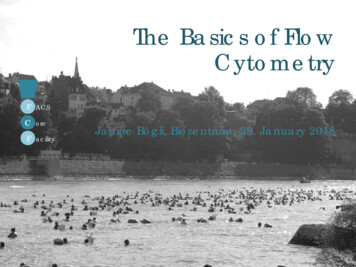
Transcription
IIE1Modul Electricity IICavendish ExperimentThe goal of this experiment is to make you familiar with the phenomenonof electrical induction. Further properties such as surface charge density,capacity, and electrical shielding based metallic balls are investigated.
Experiment IIE1 - Cavendish ExperimentThe goal of this experiment is to make you familiar with the phenomenon of electrical induction.Further properties such as surface charge density, capacity, and electrical shielding based metallicballs are investigated.c AP, Department of Physics, University of Basel, September 2016
1.1 Preliminary Questions What is induction? Describe in your own words. What is a Faraday cage and how does it work? In this experiment, you will charge a ball with a positive voltage. What is the chargecarrier that is transferred in this interaction (if any)?1.2 TheoryA conductor, by definition, contains free charge carriers. In a metal, these are electrons, butwe can find different carriers in other materials, e.g. ions in a solution. These charge carriersare free to move about the conducting material. In accordance with Coulomb’s law, chargesof the same type will repel one another. In a metal, this means that the free charges will allmigrate to the surface, where they can maximise the distance between themselves.An uncharged object contains the same number of positive and negative charges, with acharge density, D, of zero. A charged object, on the other hand, has an excess of one chargetype, with D 6 0. These excess charges create an electrostatic field, which acts to resist theaddition of further charges to the object. We can charge a conductor by applying a voltage toit. The amount of charge that can be transferred to a conductor depends on its capacity andcan be described from Gauss’s law:Q U · C,(1.1)where Q is the charge in Coulombs [C], U is the voltage (or potential difference) in volts [V]and C is the capacitance in Farads [F]. For a spherical conductor, the capacitance is proportional to the radius:C 4πǫ0 · R(1.2)With the electric field constant ǫ0 8.8541 · 10 12 mF .Figure 1.1: Induction of a positively charged sphere on two uncharged spherical shellsIn the absence of external fields, the free charge carriers in a conductor are evenly distributedon the surface (at least for a perfectly spherical conductor). As one might expect, this changeswhen we apply an external electric field, which creates an additional force to the free chargecarriers. In combination with the internal electric field (generated by the Coulomb repulsionbetween like charge carriers), the external field generates a new, nonuniform charge distribution in the conductor. We find areas with an excess of positive charge and a charge density of3
D 0, and areas with an excess of negative charge and a charge density of D 0. Repulsion between charge carriers still means that the free charge carriers remain on the surface ofthe conductor only, and not in the bulk. The influence of external electrostatic fields on thedistribution of charges is called induction or electrostatic induction.1.3 Experiment1.3.1 EquipmentComponentSphere on a standHollow Hemispheres on a standHigh voltage power supplyHigh voltage cable on a standPreamplifier for a charge measurementAluminium rod for groundingCapacitor 1 nFCapacitor 10 nFMultimeterExperiment leadsNumber12111111151.3.2 Experimental Setup and AdjustmentFigure 1.2: Scheme of the experimental setup1. Mount both of the hemispheres on tripods. Adjust their heights so that you are able tobring them together to make a single ball, or use them to enclose the solid metal sphere(see bottom of Figure 1.2)2. Switch the multimeter to the dc voltage setting, and connect the positive probe to theoutput of the preamplifier. Plug the minus probe into the preamplifier’s ground plug4
3. Use one of the provided cables to also connect the aluminium tab to the preamplifierground plug4. Connect the ground plugs of the high-voltage supply and the preamplifier together5. On the high-voltage supply, use a cable to connect the negative output with the groundplug6. Plug the high-voltage probe (the one with the pointy needle attached) into the positiveoutput of the high-voltage supply7. Plug the capacitor into the preamplifier1.3.3 ImplementationFigure 1.3: Implementation of the charge measurementThe goal now is to work out the charge on the balls and hemispheres for various experimentconfigurations. To make a measurement of the charge:1. The grounding rod should be plugged into the same plug on the preamplifier as themeasurement tip (see Figure 1.3). The preamplifier is very sensitive, and this will prevent the build-up of charge on the measurement capacitor (due to free charges in the airand stray currents) that would otherwise adversely influence the measurements.2. The multimeter should be set to Min/Max mode, and then zeroed3. You’ll want to have the grounding rod in one hand (bottom of Figure 1.3), and the useyour other hand to hold the ball/hemisphere on the measurement tip on the preamplifier (top of Figure 1.3). Remember to only hold the base of the ball/hemisphere - don’ttouch the metal itselfThe charge Q flows from the ball/hemisphere through the measurement tip to charge thecapacitor. As per equation 1.1, this creates a potential across the capacitor. The internal resistance of the multimeter gives a big error if you try to measure this potential directly. For thisreason, we will use a preamplifier, with an amplification factor of 1. The preamplifier includesan impedance converter. At the input, it has a very high resistance, and at the output, a very5
low resistance. The result is that the effective internal resistance in the multimeter is raised toaround 10 G-Ohm.The two provided capacitors can be used to measure different ranges of charge. You shouldstart with the 10 nF capacitor. If the voltage read at the multimeter is too small, then switch tothe 1 nF capacitor.Measurement of the Capacitance Discharge the ball with the grounded aluminium rod Set the voltage on the power supply to 1kV Charge the ball, by touching it gently with the tip of the high-voltage probe. Then immediately turn the power supply voltage back to zero. Measure the voltage on the ball Repeat this with 2, 3, 4, and 5 kV Repeat this with the ball replaced by the two hemispheres, pressed together so that theyform a single ballCharged Ball Discharge the ball and hemispheres with the grounded aluminium rod Set the voltage on the power supply to 3kV Charge the ball, then immediately turn the power supply voltage back to zero. Bring the two hemispheres slowly towards either side of the charged ball, so that theyare both touching the ball. Separate the hemispheres from the ball, and measure the charge on each of the threeobjects Repeat with voltages of 4kV and 5kVCharged Hemispheres / Hollow Ball Discharge the ball and hemispheres with the grounded aluminium tab Set the voltage on the power supply to 3kV Bring the two hemispheres together (making a hollow ball) and charge them up Turn the voltage supply back to zero Separate the two hemispheres, and bring them to touch either side of the ball (the sameposition as above) Separate the hemispheres, and measure the charge on each of the hemispheres and theball Repeat with voltages of 4kV and 5kV6
Charge Separation due to Induction Discharge the ball and hemispheres with the grounded aluminium rod Charge the ball with 3kV, as described above Bring the two hemispheres together (making a hollow ball). Don’t charge them though Charge the ball, and bring it towards the two hemispheres. You should bring the ball inas close as possible along a line perpendicular to the ‘equatorial plane’ of the hollow ball(i.e. the plane in which both hemispheres touch âĂŞ see fig. 1.1)). Do not actually touchthe hemispheres with the ball Take the ball away. Then separate the hemispheres, and measure the charge on thehemispheres and the ball Repeat with voltages of 4kV and 5kV1.3.4 Tasks for EvaluationDetermination of CapacitanceCalculate the charge on the surface of the solid sphere, using equation 1.1. Plot this as a function of the voltage used to charge the sphere. Perform a linear fit, and deduce the capacitanceof the solid sphere. Compare this with the theoretical capacitance of the sphere given by equation 1.2, and discuss any differences. In the same way, determine (both experimentally andtheoretically) the capacitance of the hollow sphere. What do you notice? What is the influenceof the air inside the hollow sphere? Calculate the surface charge density of the hollow andsolid spheres.Charged ballCalculate the charge on the ball and shell the three different charging voltages. Present the results in a table. How are the charges in the ball and shell distributed? Explain the distribution.Is the total charge the same as in the first exercise?Charged hemispheresAgain, calculate the charge on the ball and shells for the three different charging voltages, andpresent the results in a table. How are the charges in the ball and shell distributed? Explainthe distribution. Compare the total charge with the values from the first and second exercises.Charge separation through inductionOnce more, calculate the charge on the ball and shells for the three different charging voltages,and present the results in a table. Explain the measured distribution of positive and negativecharge. Did the charge on the solid ball change due to inductance? Explain, and compare withthe first exercise.7
1.4 Literature Paul A. Tipler, Physik für Naturwissenschaftler und Ingenieure, Spektrum Horst Stöcker, Taschenbuch der Physik, Verlag Harri Deutsch8
Describe in your own words. What is a Faraday cage and how does it work? In this experiment, you will charge a ball with a positive voltage. What is the charge-carrier that is transferred in this interaction (if any)? 1.2 Theory A conductor, by definition, contains free charge carriers. In a metal, these are electrons, but we can find different carriers in other materials, e.g. ions .

